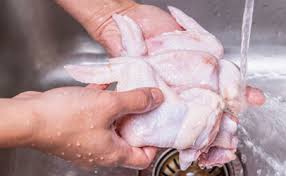 Growing up in the south, fried chicken was a family favorite. Through my grandmother, I learned how to prepare chicken that was the perfect combo of juicy chicken and crispy crust. CHICKEN RECIPE . Until I got older, I didn’t understand the importance of food sanitation and preventing food contamination. Chicken is a breeding ground for numerous types of bacteria, including salmonella and staphylococcus that can make you incredibly sick. That’s why I have decided to share with you some tips on preparing and cooking chicken safely.
Growing up in the south, fried chicken was a family favorite. Through my grandmother, I learned how to prepare chicken that was the perfect combo of juicy chicken and crispy crust. CHICKEN RECIPE . Until I got older, I didn’t understand the importance of food sanitation and preventing food contamination. Chicken is a breeding ground for numerous types of bacteria, including salmonella and staphylococcus that can make you incredibly sick. That’s why I have decided to share with you some tips on preparing and cooking chicken safely.
- Raw chicken should always be stored in a sealed container on the bottom shelf of your refrigerator so that it doesn’t come in contact with other foods, especially cheese and fruit.
- If you plan to freeze your chicken, you should do this as soon as you get it home from the store. Chicken can be frozen in its original packaging. However, if you plan to freeze it for more than two months, wrap the package it is in with an airtight plastic wrap, freezer paper, or foil. You can also put the entire package in a freezer bag or repackage it in airtight freezer containers.
- Never leave chicken lying out on the counter in an attempt to defrost it. Place it in the refrigerator. You also have the option of placing it in cold water if there are no leaks in the packaging. Keep in mind that it can take 1 or 2 days for an entire chicken to thaw, so plan accordingly.
- Do NOT wash chicken before you cook it. The process of cooking the chicken will kill any bacteria. Washing it simply makes it easier for bacteria to spread around the kitchen through contaminated drops of water.
- Before you touch raw chicken, wash your hands. After you have touched raw chicken, wash your hands. Anytime you have to touch something else, from grabbing a knife to cut it with to opening a cabinet to get a plate to put the chicken on, wash your hands. If you find yourself wondering whether or not you need to wash your hands, wash them. This is the best way to prevent food contamination.
- Use a separate cutting board for chicken and other meats than you use for veggies and fruits.
- The safest way to determine if chicken is completely cooked is by using a meat thermometer. When the internal temperature reaches 165°F, it is safe to eat. If you do not have a thermometer, make sure the chicken has steam emerging from it and that there is no pink on the interior. All juices should be clear.
- If you are cooking an entire chicken, check the thickest part of the leg to determine whether or not it is safe to eat. This is the area of the chicken that takes the longest to cook.
- If you plan to refrigerate chicken allow it to cool for one hour before you put it in the refrigerator. However, do not leave it sitting out for more than an hour.
- Leftover chicken is usually safe to eat for two to three days after it has been cooked. However, if it smells funny, throw it away.
- When reheating cooked chicken, it must be piping hot all the way through to be considered safe to eat.
Chicken is a quick and easy meal option. Just be sure to follow the chicken safety tips discussed above to prevent any contamination